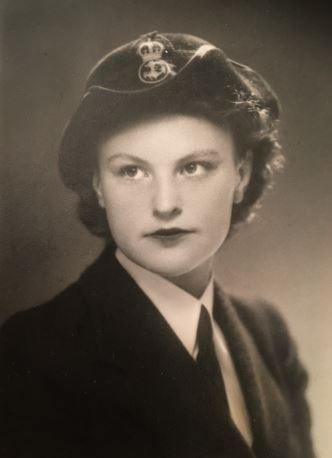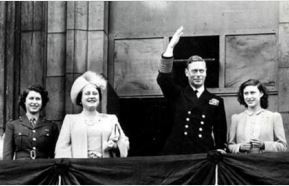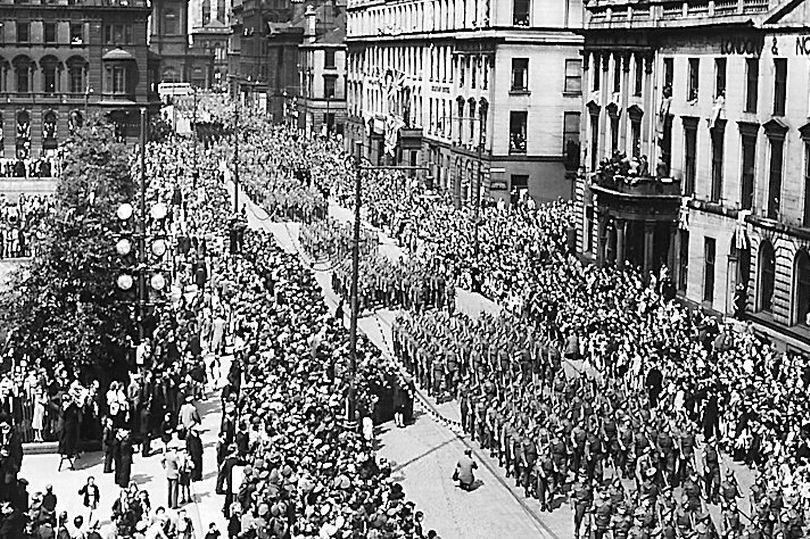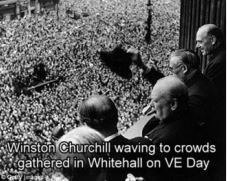|
|
|
May the 8th this year marks the 75th anniversary of one of the most memorable events in the lives of our older members, Victory in Europe Day, when the whole of Britain let its hair down in bunting-bedecked parades and street parties in joyful celebration for the end of almost six years of war in the western hemisphere.
The Royal Family in London |
George Square, Glasgow | Whitehall, London |
I was a mere six-year-old, writes Stuart Campbell, staying in Morcambe with my mother while recuperating from a rather painful operation to remove my tonsils at the Bradford Ear, Nose and Throat Hospital which, I believe, was in Manningham at that time. My enduring memory is of consuming copious quantities of soothing ice cream in streets strewn with flags.
But it is Pam Rae, one of our founder members, to whom we must turn for this remarkable account of her memorable day:
 In 1945 I was a Leading Wren radar mechanic based at the port radar office on the Clyde. Our job was to install radar sets in destroyers, cruisers and aircraft carriers as new builds or when they came in for refit.
In 1945 I was a Leading Wren radar mechanic based at the port radar office on the Clyde. Our job was to install radar sets in destroyers, cruisers and aircraft carriers as new builds or when they came in for refit.
On VE day we were drafted in to march in a Victory Parade through the streets of Glasgow. This really was a great occasion, with bands and cheers and flags flying. We did our best to march in step and felt very proud of being in the Navy. I was so impressed by this amazing day that, as a budding journalist, I wrote an article about it "by a Leading Wren" which was published in the Glasgow Bulletin, one of the city's favourite newspapers. This was a big mistake however, as I soon found out.
Summoned to an interview with our Wren officer, who had hurriedly asked around till she found the culprit, I discovered that I was in deep trouble. I would have to appear before the Commander (Intelligence) Western Approaches - a truly awesome title. His office was in the St. Enoch’s Hotel, which was then commandeered by the Admiralty. My crime consisted of "communicating with the Press, contrary to K.R.s and A. I.s (King’s Regulations and Admiralty Instructions)". Needless to say, nobody had ever warned us of this crime. I was instructed to wear my Number One uniform with hat band round my chin, instead of being tucked inside, and lisle stockings, not silk.
I walked the long corridors in some fear and trembling and eventually found the right office. I felt I might easily be sent to the Tower for treason, or at least suffer some serious punishment. The Commander looked me up and down as I stood at attention. The interview was brief, but he was not unfriendly. It was a very interesting article, he said, but never do it again. I was reprimanded in a kindly way and was only punished by being docked three days’ pay. Safer by far to keep silent while in the Services!
Roger Goulden writes:
I was eleven months old on VE Day so have no memories.
I was living with my mum and her parents. I can't even remember seeing my dad for the first time almost another year later. He survived Dunkirk and came home in half a pair of pyjamas. He sent a card “Safe in England”. His mum was persuaded to go on a trip to Matlock from Birmingham. She saw him on the back of a lorry but could only wave.
My mum and dad decided to marry as soon as they could and my mum found lodgings in Shropshire to be near him. My dad celebrated my birth by escaping under the wire while waiting for D Day.
I have his pay book that was changed in early 1945 but there Is no trace of him online. His medical fitness score went from A1 in October 1941 to B7 just before D Day.
He never spoke about his war. In 1961 he was driving my mother and two friends back from a holiday in Italy. Their booking was moved from Calais to Dunkirk. My mum said he produced an unintelligible running commentary. He had been a truck driver so we assume he had used some of the same roads. We also think he was involved in the liberation of Belsen.
He died when he was sixty. Hazel and I had just got married and he was beginning to enjoy life. He had a small butchers shop and wanted to stay with friends in France to learn to prepare meat using French techniques. I don't think he lived long enough to celebrate and I was too young.
Pratima Shaw writes:
VE Day 1945 I was on holiday with my mother, aunt, grandmother and older brother in Anglesey. My aunt, who worked as a Supervisor for Manchester Transport, had found a holiday place in part of some Welsh people’s house for £5 a week! Self-catering!! My aunt financed the family holiday.
I remember walking along the Anglesey coastal path from Beaumaris to Penmon Point rejoicing with everyone as I saw the puffins & wonderful abundance of primroses growing under the hedges.
Eric Verge, Commander, Royal Navy writes:
On VE day late morning I was aboard HMS BELFAST, a midshipman on the bridge. We had just finished sea trials after refit on the Tyne in preparation for service in the Far East. We were approaching the Forth Bridge when a Flying Fortress of USAF flew low over us and then thru the arch of the bridge immediately ahead. Very exciting but a highly hazardous exercise. When we were secured in Rosyth we ‘spliced the main brace’ (extra ration of rum) on instructions from the King. As officers were included this was my first taste of Navy rum, which I did not enjoy.
This ceremony was to be repeated a few months later when I was in Rangoon serving in HMS LOCH LOMOND on VJ day. We were preparing for the invasion of Malaya. We then saw the Japanese aircraft flying in with their generals to sign the surrender documents for their forces in Burma. We sailed instead to Singapore where we entertained dozens of POWs who had made their way to the harbour. They filled every ship’s boat arriving at the passenger landing. They were a starved gaunt group and very anxious to talk about their privations and treatment whilst prisoners.
Select or click here to listen to the U3A Founder Member interviews if you have not already done so.
You are here >>>>> |
|



